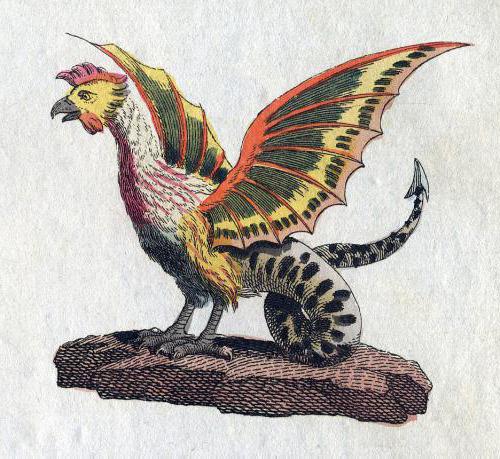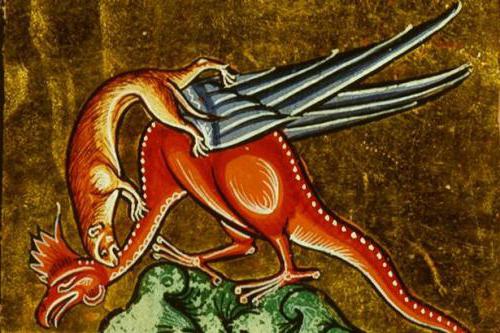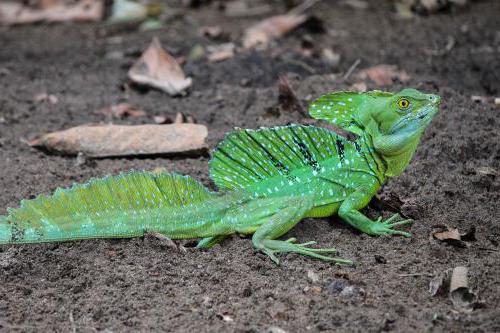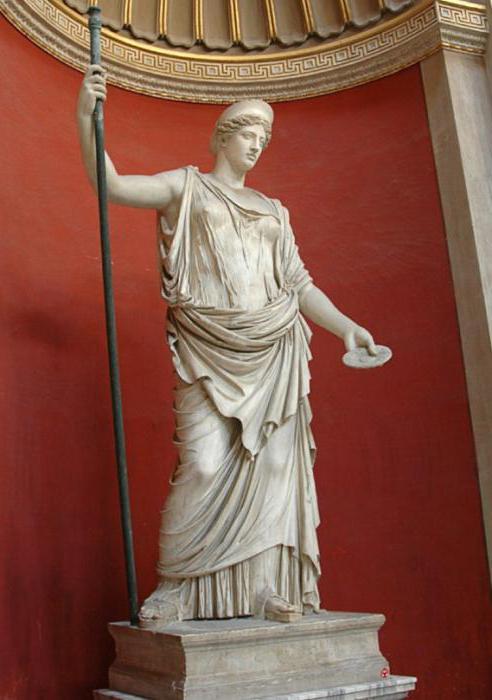One of the most dangerous creatures described inMedieval bestiaries - is a basilisk. The mythology of Europe attributed to him an unimaginable appearance and lethal look. However, the first mention of the monster dates back to ancient times. Like many other supernatural beings, the basilisk often appears on the pages of modern science fiction authors. Among them is JK Rowling, who made the terrible snake one of Harry Potter's rivals. Basilisk is also mentioned in the Bible. Let's try to figure out why the “king of the snakes” is so loved by the authors and why they were afraid of him in the Middle Ages.

How it all began
The most ancient source of knowledge about the creature undername "Basilisk" - ancient mythology. However, no, not mythology, but rather scientific treatises. The Basilisk is mentioned by Pliny the Elder in his Natural History, dated to the 1st century AD. e. and based on more ancient Greek sources. The Roman author describes the creature as a small snake (only 30 cm in length) with a white spot on the forehead. Pliny notes the deadly force of the animal: from his breath and touch, herbs dry out and stones light up. Everyone who sees him perishes. Basilisk - the king of snakes. Creeping reptiles in fear rush in different directions as the master approaches. The basilisk itself moves, half raising the body above the ground.
Perhaps it is a white spot in shaperesembling a crown, was the cause of the majestic name. Basilisk in Greek means "king." The creature's other name is regulus, that is, the “small king”. According to the report of Pliny, a basilisk lived in North Africa, in the Libyan desert. According to some researchers, the further transformation of the mythical creature is likely to be due to the destruction of ties between Europe and Africa after the fall of the Roman Empire.
Basilisk in Egypt
The prototype of a mythological creature is calledoften the Egyptian cobra. This habit is characterized by the “habit” of moving, straightening the front part of the body above the ground. The horned viper also has a certain similarity with the mythical creature. Some researchers, taking into account such considerations, believe that often decorated images of pharaohs of snakes are basilisks, and not ordinary reptiles.
In the Middle Ages, a terrible creature acquired a lotbird features The origins of such "transformations" can also be found in Egypt. Some question researchers point to stories related to ibis. This bird destroys the serpent tribe throughout life. The reptile eggs are her favorite treat. The Egyptians believed that the ibis sometimes laid snake eggs itself. Roman author Kassian directly says that basilisks originate from such birds.
Cockroot Roots

In the Middle Ages, the image of a basilisk is overgrown with new ones.frightening details. Other ideas about his “pedigree” and the conditions accompanying birth appear. The look of the monster is changing. Now he appears in the form of semi-semi-semi-semi. The crown on the head is transformed into a cockscomb, the body often seems to be a toad. From the snake remains only a long tail. Sometimes basilisk supplement the wings of the bat. Significantly increase the size of the monster. Now the basilisk is considered not a 30-centimeter snake, but a creature as tall as a horse that reared.
The progenitor of the monster is called the old rooster,some sources should be 7 years old, according to others - 100. He lays an egg in a pile of manure. It is hatched by a toad. According to other legends, the egg laid by the rooster should carry a virgin under her arm for six weeks. And only then the basilisk will hatch, ready to carry out all the orders of the girl.
Interestingly, the cock that gave birth to the monster could have killed him. According to the legends, the basilisk is nocturnal, because the rooster's cry can kill him.
Habitat

With a change in ideas about the origin andAppearance and new descriptions of places where the basilisk can find themselves appear. The mythology of the Middle Ages significantly expands its habitat. Deserts and caves are still the favorite places of the monster. According to the legends, the basilisk chose such a dwelling with a utilitarian purpose: he ate stones. However, in the Middle Ages, the monster lived not only in distant Africa, but practically throughout Europe. You could easily stumble upon it right at your own house.
Deadly poison
How dangerous is basilisk?Mythology of mystery from this did not. Basilisk poison possessed, according to ancient and medieval sources, almost instant action. It spread through the air, through blood and touch. In the Middle Ages, the basilisk's ability to kill with a glance received an interesting explanation: the deadly poison is activated in the body of the creature under the impression of what they see, is secreted through the lacrimal glands, and then reaches the hapless person by the air.
Means of struggle
What kind of weapon is the basilisk afraid of?Mythology indicates that it is almost impossible to defeat a monster with a sword or spear. Any touch to the body of the creature leads to the death of the brave. Pliny has described a case where a rider pierced a basilisk with a spear. The poison reached the man and killed both him and the horse under him.
However, in the mythological tales there is not onecreatures against which there would be no weapon. According to legends, Alexander of Macedon invented one of the ways to fight the basilisk. He put an ordinary mirror in front of the monster. Poison, reflected from a smooth surface, struck a basilisk.
In the Middle Ages, travelers who went to badstudied edges, it was recommended to take a rooster. As described above, his cry frightened and even killed the Basilisks. Another animal, able to resist a terrible creature, was considered a weasel. For the first time about the opposition of the animal and the basilisk was mentioned in the work, dating from the III century BC. e. Its author is considered to be Democritus. The ancient philosopher notes that not every kind of affection can fight a basilisk, but only the one who ate the leaves of rue. The plant gives the animal courage. Weasel is able to find a basilisk even in his lair. To protect the water, an image of an animal with leaves of rue in its teeth was often placed on wells.

Slavic mythology: basilisk - sinitel
Basilisk is not so popular in Slavic mythology.character, but the place he found here. In general, he has the same frightening features. Due to the similar sound in the peasant environment, the image of the wonder-snake influenced the idea of cornflower. He was considered fascinating and all-pervading, like the monster's poison. The basilisk was called the "sintelite" or "cornflower sovereign." On Vasilkov day, which fell on June 4, it was impossible to sow and plow. If we ignore the rule, it was possible to ensure that the entire field is overgrown with cornflowers.

Magic views
Not only Basilisk - mythical creaturesGreek mythology and the Middle Ages were generally reflected in the practice of alchemists and magicians. However, the value of the monster in these branches of knowledge is especially great. Basilisk was an embodiment of wisdom, cruelly punishing those who are not ready to accept it, but trying to try on themselves. From this point of view, one can explain the common plot in the visual arts: a basilisk devours a person. He may have magical undertones. Basilisk, personifying wisdom, transforms his chosen one, initiates his transition to a new level of knowledge.
Lizard that can walk on water

Увидеть василиска можно и в наше время.And for this it is not necessary to go to the cinema or immerse yourself in magical practices. In nature, there is a lizard basilisk (Basiliscus plumifrons). The small and harmless reptile has a bright green color, long claws on its paws, an impressive tail and powerful hind legs. The males of such lizards are distinguished by a spectacular crest on the head, which makes them very similar to the mythological monsters. The amazing ability of a helmet-bearing basilisk is the ability to walk on water. It can reach speeds of up to 12 km / h and, quickly striking with its hind legs, cross, for example, a pond without getting wet. For this ability, residents of Central and South America, where the lizard lives, are treated with great respect. The ability to walk on water causes the image of Jesus in their memory.

Symbol of wisdom and royalty, terrifyingdanger and harmless reptile - all this is a basilisk. The mythology of antiquity and the Middle Ages gave the world a magnificent image, often appearing now in heraldry and in the pages of fantastic works. Basilisk is now before its bright symbol of the danger of knowledge for the uninitiated. That is why his popularity with the authors of fiction is so great.











